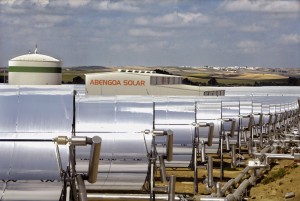Starafrica.com
Posted by: PR Newswire
Situation : With over 300 days of sunshine per year, Ain Beni Mathar in Morocco, near the border with Algeria, was the perfect site to build a thermal and solar hybrid plant.The first of its kind in Africa, Ain Beni Mathar is a real opportunity for Morocco to explore alternative sources. The country suffers greatly from its energy dependence, importing 97% of its coal and oil energy needs.
Objectives : The Ain Beni Mathar (ABM) thermosolar plant project is intended to broaden access to electricity by developing renewable energy to support economic growth, rural electrification, and the competitiveness of Moroccan businesses. The project ties in with the strategic thrusts of the national energy policy. Its objective is to help to limit the country’s oil bill and its dependence on petroleum products, while meeting the need for low-cost electricity, ensuring satisfactory service and quality conditions, and limiting environmental impact in line with Morocco’s commitments at the Johannesburg Earth Summit in 2002 and the Kyoto Protocol of 1997.
Project specificity : The Ain Ben Mathar Integrated Solar Thermal Combined Cycle Power Station was the Bank’s first experience in solar power. This plant combines solar power and thermal power. The use of this system helped reducing the national fuel bill, and avoids the emissions of 1,000 tons of CO2 per year compared to a fully gas-powered plant.The plant meets strict environmental standards – allowing Morocco to save 12,000 tons of fuel oil per year. To halt its energy dependence, Morocco has implemented plans to produce 40% of renewable energy by 2020.
Impact on population :
approximately 500 workers were employed by the project of which 250 were taken up by people from the ABM village Facilities were developed to provide accommodation and catering for workers. Thus, local small business activities were boosted and indirect jobs (food, transport, accommodation) created; local SMEs provided support services, which helped develop regional industrial activities.
The access road and the bridges benefit the inhabitants of rural villages, by linking them with the region of the power plant. Previously, in the rainy season, no road was accessible and some people were very isolated. The project facilitated access to social services and schools for inhabitants ( increase in the number of kids at school in the region), especially women, who are active in trade and goods circulation. The gender impact was real: since 2009 , women are now represented in the village council of Beni Mathar, they are more numerous in NGOs. There was also no rural exodus . The figure of inhabitants has stayed stable ( 1128 households).
The construction of three wells for the water supply of the power plant ensures regular irrigation of the lands in the neighborhood, thus generating food supply and regular income for people working on those lands.
The income generated in the region by the sale of the land for the construction of the power plant helped construct four schools and three rural roads.
The rural village of Ain Beni Mathar has benefitted from social activities undertaken by ONEE and the lead contractor Abengoa: construction of water supply boreholes in the rural villages of the region; 20,000 schoolbags distributed in two years; contributions to the construction of the village mosque; distribution of computers, printers and office materials; and distribution of 200 bicycles for students going to schools.
Other beneficiaries
There are many beneficiaries. The Moroccan population as a whole and various economic sectors benefit from the new reliability of electricity supply in the country. ONEE’s commercial, industrial and domestic customer base benefits from the availability of low-cost electrical energy. ONEE benefits from greater production capacity. The Moroccan Government has stabilised its oil bill because of the increase in the use of non-fossil fuel for electricity generation and has thus improved its balance of payments.
National and international companies have responded to bid invitations for the implementation of works under the various components of the project. They have benefited from construction of the Ain Beni Mathar power plant under the terms of supply contracts for goods, works or services, which they have signed with partners.
Lessons learnt
The main lessons the AfDB has learned from implementation of this project is that special attention must be paid to (i) quality at entry, (ii) procurement procedures for selecting contractors responsible for implementing works so as to avoid delays, (iii) consideration of best practices by project implementation units, and (vi) the need to familiarise and train officials of executing agencies and ministries on the rules and procedures governing the Bank’s procurement, disbursement, project audit and results-based management.
These lessons have already been applied in the preparation of the Ouarzazate solar power plant (for which the AfDB approved financing in 2012). For this and future projects, the Morocco Agency for Solar Energy (MASEN) created a data room for the basic documents necessary for proper project execution, and signed a confidentiality agreement. It also conducted training sessions on the AfDB’s procurement rules and procedures. Regular meetings of major donors involved in the sector were established to harmonise procedures.
The lessons learned about concentrated solar power technology in particular (cost, storage, local manufacturing and maintenance) helped the Moroccan authorities design and obtain the financing for the Ouarzazate project.
SOURCE: African Development Bank (AfDB)








